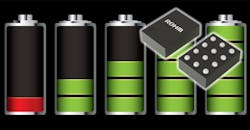Buck-Boost DC-DC Converter Targets Eco-Friendly Devices
ROHM recently announced the availability of a buck-boost dc-dc converter with integrated MOSFET, the BD83070GWL. It combines efficiency with best-in-class current consumption, claims the company. This makes it suitable for Internet of Things (IoT), wearables, and portable devices.
In recent years, the proliferation of battery-driven electronic devices has increased the demand for smaller components that can provide the necessary design flexibility and space for integrating new functions while minimizing power consumption to maximize battery life. In response, ROHM developed a power-supply IC that meets market needs by leveraging a vertically integrated production system using in-house analog design expertise and specialized power processes. At the same time, high-efficiency low-power boost (BU33UV7NUX), and buck (BD70522GUL) power-supply ICs are available that allow users to extend the operating time of battery-powered applications.
According to ROHM, the BD83070GWL was developed to be the best-in-class product for low-power eco-friendly devices used in compact battery-driven applications. The built-in low-RDS(on) MOSFET and low control current circuitry achieve a power-conversion efficiency of 97% during operation (at 200-mA load current) along with a 2.8-μA quiescent current consumption. This contributes to a longer operating time in compact battery-driven devices, prolonging battery life by as much as 1.53 times when compared with other conventional products during standby (100-μA load current), claims the company. An evaluation board integrating this converter is also available.
Availability
Now (samples), October 2019 (OEM quantities)
Key Features
The 1.2- x 1.6-mm BD83070GWL provides the following features:
- Ensures high efficiency over a broad range of load current: Integrating a low-RDS(on) MOSFET with a 0.13-μm BiCDMOS power process allows the device to achieve a power-conversion efficiency of 97% during operation (200-mA load current), and over 90% efficiency at other light loads (from 100 μA) to heavy loads (1 A). This enables high-efficiency power conversion in a variety of battery-powered applications. ROHM’s original control technology (X Ramp PWM Control) permits seamless buck-boost transition. [Patent Nos.: 2015-121194, 2016-243569, 2018-023007]
- Buck-boost power-supply IC achieves low current consumption (2.8 μA): It combines low current consumption and fast response, and an optimized switching control function adapts to different load conditions to reduce loss results in a current consumption of 2.8 μA. [Patent Nos.: 2016-253301, 2016-253303]
Application Examples
- Coin cell battery equipped sets (i.e., IoT)
- Lithium-ion (Li-ion) battery devices, including smartphones, tablets, and PCs
- Battery-driven equipment such as toys and electric toothbrushes
Evaluation Boards
Evaluation board part no.: BD83070GWL-EVK-001
For more information, visit here.

